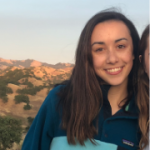
Hi, my name is Emma and I am a 16-year-old from the Bay Area. I’ve been recently diagnosed with spondylitis and am starting to get treated. My first memory of an AS symptom was a late-night soccer game. I was a thirteen-year-old center midfielder with hopes of college soccer. Seemingly out of nowhere, I had a sharp pain in my left hip that remains there today. My coach and parents were confused because I suffered no visible injury, yet I couldn’t run without a limp. I would swear that something was going on, but the doctor that concluded I was fine didn’t help my cause. He said it was growing pains, something most kids go through. I didn’t know why I wasn’t as tough as the other girls who seemed to play through it with no problem. I had a great coach and teammates, but I would force myself through the practices, counting down the minutes until I could stop running. Most of all, I missed the times I could focus on playing well instead of the incessant pain.
Some days were better than others, and by the time I was a freshman in high school, I felt good enough to join the cross-country team. I would run three to five miles with varsity and then head off to soccer practice. Most of the time I had no problem. Unfortunately, my symptoms came back when high school soccer started in the winter. I had a good tryout, but as soon as I started practicing with the team all my pain started to slowly creep back. It wasn’t the season I hoped for, but thanks to Advil I made it to the end. I kept going to all sorts of doctors: pediatricians, sports medicine, orthopedic surgeons, and physical therapists. The answer I got then was overuse and possibly Osgood Schlatter. Nothing was for certain and nothing was really helping, so when my sophomore year came around, I knew I could no longer run cross country. I played tennis instead, and I actually really enjoyed it. I was able to play through occasional pain as it was significantly less demanding than soccer or cross country.
As the winter sports season was approaching, I was determined to have a better soccer season than my freshman year. Due to the few problems I had with tennis, I was optimistic. I made the varsity team and was super excited to play. The first few weeks were great, but I pretty much sat on the bench the rest of the time. The freezing cold weather, weight lifting, and quick movements didn’t exactly help my joints. My pain was worse than ever, and what was I supposed to tell my coach? That I was still having growing pains at fifteen? It wouldn’t really explain why I was so inconsistent day to day and unable to run as fast as the other girls. I felt self-conscious about not being able to lift a quarter of what my teammates did, or even do a full squat. I remember standing off to the side while my friend Emily would do box jumps, wondering why she was able to do this with ease while I had a hard time getting up a single step. The main coach was really supportive and nice about it, but one of the assistant coaches was pretty tough. My parents, although they meant the best, also didn’t understand why I couldn’t just play like everyone else if the doctors said nothing was wrong. At one point they thought I was exaggerating in order to get out of going to soccer practice. They seemed upset that I no longer enjoyed playing. I was really frustrated, and by then I had lost all confidence in my athletic ability. I thought I was weak and not working hard enough. I went from running a mile in under six minutes to not making it through one warm-up lap before practice. After that season, I stopped all sports, hoping rest would be the answer. After my symptoms continued to get worse, I felt like I was back to square one. I went to physical therapy once a week, where the doctor was determined posture and core exercises would be the panacea for all my leg issues. Although I knew this wasn’t helping, I didn’t say anything because I felt like my case was hopeless anyways. The orthopedic surgeon I saw next concluded nothing was wrong after looking at an MRI and suggested that I stretch more.
By then I started to accept I would just have to deal with this and try my best to push through it. I got used to things like taking forever to get up from my seat when class ended. In the mornings I would feel guilty for making my neighbor Maddie wait for me to hobble up the stairs to school. I couldn’t even sneeze without sharp pain, and people were starting to notice there was something different about the way I walk. When I realized that some nights I couldn’t even turn over in my bed without writhing in pain, I knew that the problem was bigger than stretching.
What eventually led to my diagnosis was waking up with a bright red eye. At first, I assumed it was pink eye because I tried on sunglasses with my friend Katie the night before, but after a visit to the ophthalmologist it turned out to be iritis, inflammation in the anterior chamber of your eye. For the next month, I had to explain to everyone why I had to avoid direct sunlight (to the point of wearing sunglasses inside my house) and leave class to dilate my pupil and put in prednisone drops.
As a sophomore in high school I was kind of embarrassed of the way my eye looked, but now I am very thankful it happened. When I was talking to the ophthalmologist for the first time, he asked me about my hip pain. I was really confused. He was an eye doctor, right? I explained what I had been experiencing the past few years, but I still didn’t know how something going on in my eye could be related to my hip. He suggested I see a rheumatologist, as iritis can be tied to arthritis. Other doctors told me it was very unlikely I had any arthritic problems, so we didn’t really consider it before. After a positive HLA-B27 test and an MRI with contrast, the rheumatologist confirmed I had ankylosing spondylitis. I was sixteen, about to take my driver’s test, wasn’t that too young for arthritis? It was a weird experience looking through WebMD to find all the pain I had experienced put into words. I was surprised to see the statistic of 1 in 100 because it seemed like such an esoteric disease; I don’t think I’d heard the word spondylitis my entire life. Even though being told you have a chronic disease is not good news, I was relieved to know I wasn’t just imagining the pain in my head. The NSAIDs I am taking are helping me a little bit, but I’ve cut back significantly on sports. It’s been tricky to continue my past activities, even the ones that aren’t active, but as of now I still manage most of them. I’ll be going into my third year as class president this fall, and I’m hoping to be able to play tennis when school starts. I still play guitar, referee youth soccer, and tutor history and math. Day-to-day things can still be a struggle, but life goes on. One good thing that has come out of this is I’ve learned to be more disciplined and deliberate with my actions. I have to set an alarm early to stretch, eat breakfast every day so I can take food with my medicine, build in extra time to walk to my classes, and stop making excuses to not run or exercise. These things can be annoying, but I know that the pain from not doing them is worse. It’s hard to deal with a disease that none of my family or friends understand, but I am really lucky to be going through it at a time when there are so many resources and treatment options.



